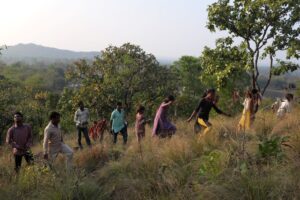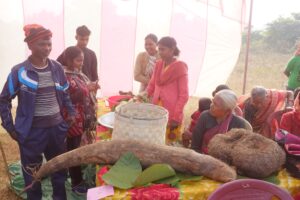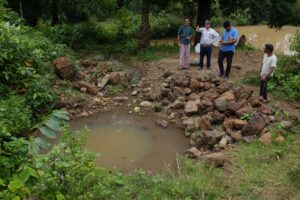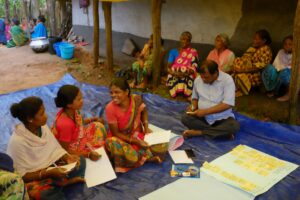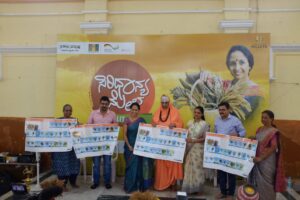Depositing traditional seeds collected from Kukdur, Kabirdham District, Chhattisgarh to Community Seed Bank at Makhni Pahar Village, Amrapara Block, Pakur District, Jharkhand – 22nd May, 2018
The UD fellow for the Paharia project villages of Amarapara Block in Jharkhand, Kalidas Malto has established a community seed bank in Makhni Pahar his home villages. He has already stocked the seed bank with a number of local varieties as per requirements of local farmers. The seeds are currently being stored in traditional earthen pots which are sealed to prevent damage of seeds by insects and rodents. In the course of meetings with Paharia farmers of project villages a number of traditional crops were identified the availability of whose seeds in the area had diminished considerably or vanished totally. In order to promote the revival of these crops which were traditionally grown and consumed in this region I had sourced seeds of a number of these crops from the Baigas of Kukdur, Kabidham District Chhattisgarh through the support of Naresh Bunkar who works extensively in that area.
The seeds provided to the Community Seed Bank at Makhni Pahar were as follows:
| Sr. No. | Name of Seed in Baiga | Name of seed in Paharia |
| 1 | Lal Madia | Batwe |
| 2 | Bade Kodo | Koda/Janhe |
| 3 | Bade Dongar Kutki | |
| 4 | Katki Kang | Patge/Gundli |
| 5 | Sikia | Layo |
| 6 | Sitahi Kutki | Gunjlii |
 Men and women farmers gathered outside the community seed bank to inspect the newly arrived seeds. While some of the younger villagers found it hard to correctly identify all the seed varieties, older villagers could identify them and some even remembered cultivating them themselves in the past. These seeds will be distributed in small quantities to farmers in Amrapara and Sundar Pahari with the objective of creating a larger stock of these farmers which can cater to more farmers interested in cultivating them in years to come. Kalidas has already identified a number of farmers keen to cultivate these seeds on their lands. When discussing processing of these different crops one of the women pointed out that in the past their ancestors used to manually de-husk the seeds but now very few villagers are still carrying out manual de-husking.
Men and women farmers gathered outside the community seed bank to inspect the newly arrived seeds. While some of the younger villagers found it hard to correctly identify all the seed varieties, older villagers could identify them and some even remembered cultivating them themselves in the past. These seeds will be distributed in small quantities to farmers in Amrapara and Sundar Pahari with the objective of creating a larger stock of these farmers which can cater to more farmers interested in cultivating them in years to come. Kalidas has already identified a number of farmers keen to cultivate these seeds on their lands. When discussing processing of these different crops one of the women pointed out that in the past their ancestors used to manually de-husk the seeds but now very few villagers are still carrying out manual de-husking.
After the seeds were received by Kalidas there was an informal discussion with men and women villagers regarding traditional agricultural practices of the Paharias. Kalidas described the Paharias’ traditional pujas associated with agriculture –
i. Makai puja – which is celebrated in between August and October when Makai ripens
ii. Kosra Peejeh (Barbatti Puja) – is celebrated in between November and January when barbatti ripens.
iii. Poon Tadi (Bajra Puja) – celebrated in between February and March when Bajra ripens
iv. Tatgh Peejeh (Mango Puja) – is celebrated in between April and May after the forming of the mango fruit and before it ripens.
He emphasised that in the past no new crop was consumed till the appropriate puja was performed. However, of late in the light of modernisation and related cultural and religious changes among the Paharia community there has been a sharp decline in the celebrating and following of these traditional customs and pujas. Along these lines there has also been a gradual decline in traditional mixed cropping agricultural practices with most farmers shifting to modern mono-cropping methods.
Visits to Gadh Pahari, Busu Tola – Kathal Para and Kerodoli villages – 23rd May 2018
On the morning of 23rd May we first visited Silas Malto in Gadh Pahari village which has 34 Paharia households. Silas was part of the team from Amrapara which had participated in the UD Annual meeting in Bhopal and he shared the problems he and fellow villagers are currently facing with regards to the tenure of their agricultural land. While he and other villagers are residing here in Gadh Pahari their agricultural land comes under an area known as Doh Pahari for which they have a map from the British Period which clearly demarcates land for different families the decendants of home now reside in Gadh Pahari. Silas is the Pradhan for Doh Pahari but this as well as the land rights of other villagers who reside in Gadh Pahari but have agricultural land in Doh Pahari is being challenged by the administration on the grounds that the officially now reside in Gadh Pahari though as per the old map they have land rights in Doh Pahari. These issues are along the lines of problems faced by villages across Jharkhand with regards to the legality of land settlement during the British period and requires further investigation, follow up and advocacy with concerned departments at various levels (block, District and State).
We then visited Busu Tola of Kathal Para villages where we met and interacted with Parmeshwar Malto a senior Paharia farmer. Parmeshwar was very keen to cultivate several of the seed varieties from the Baiga areas of Chhattisgarh which had been lost in his area. We also discussed FRA and CFR related issues and he pointed out that there was no awareness of CFR in his village but they would definitely benefit from CFR titles over their forests which are integral to their livelihood security. On our way back to Makhni Pahar we stopped by Kairodoli village and met the Pradhan Sanjay Malto who came across as very committed to taking forward CFR claims in his village. He was very keen to have village level meetings to spread greater awareness of CFR and to mobilise villagers to come together to jointly carry out the necessary processes to compile and submit a CFR claim over the forests Kairodoli depends on.
Learning
There has been considerable erosion of traditional mixed cropping agricultural practices and traditional crops in this region. The cultivation of several traditional crops has diminished considerably or ceased completely. While efforts to revive cultivation of seeds that have diminished or vanished from the area are a positive step there needs to be a holistic approach in order to ensure effective revival of these varieties. There needs to be concerted efforts to spread awareness about the benefits of these crops and traditional agricultural practices among Paharia farmers. Most of the current generation have never consumed these crops and there should be efforts to promote an understanding of processing and preparation methods, benefits of consuming these crops and instilling a sense of pride associated with reviving crops that were an integral part of their culture and tradition which ensured health and nutrition of their ancestors. There could be a possible inter-community exchange on traditional seeds and agricultural practices with Baiga farmers coming to Amrapara for a program with farmers of the area.
My travels through project villages revealed that much of the forests appeared to be degraded and this was backed up by data on community forests of Makhni Pahar collected by Kalidas. All five community forest areas near Makhni Pahar have been described as degraded by Kalidas. There is a need to explore reasons for this degradation and community based solutions to promote regeneration. However, effective community efforts to manage and regenerate these forests might not be feasible till a semblance of secure land tenure over these areas, possibly through CFR or PESA, is established.
There is no awareness or implementation of FRA in project villages barring initial efforts by Kalidas. However, villages are aware of potential threats to their access to these forests and are keen to understand FRA and commence the process of formulating and submitting CFR claims. In the light of the lack of awareness and precedent regarding CFR claims in the region it might be a good area to choose a pilot village with good cohesion and unity among its residents and support them in commencing and carrying out the entire process of compiling and submitting CFR claims to the competent authority. This can be built on and replicated in other villages.


